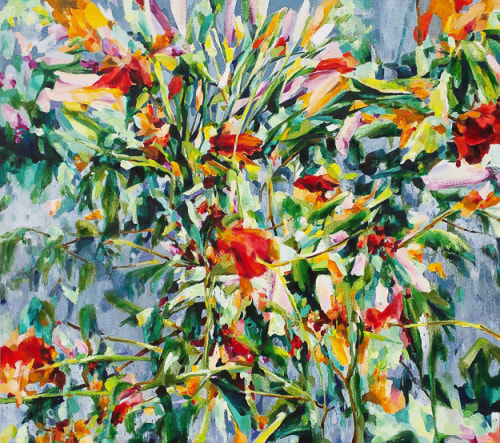
The United States is a patchwork nation in the largest painting in Tim Doud’s Hemphill Artworks show. “Proposal for a Future Flag (Template)” is a seamless triptych that in total measures roughly 17 feet wide by 10 feet high. The picture leans against the wall at a slight angle, since it’s a bit too tall for the room. Yet the huge speculative banner is not the only magnum opus in Doud’s show, which is titled “Prolepsis” after the literary device of referring to a future event in the present tense.
A D.C. painter who teaches at American University, Doud long specialized in lushly realist portraits of people who sometimes wear flamboyant outfits of their own choosing. In recent years, the artist’s interest in clothing has led to seemingly abstract pictures derived from fabric patterns and textures. Doud’s flag is a sprawling cluster of such swatches, painted in acrylic and oil enamel and figuratively stitched together with letters — notably “U,” “S” and “A” — that are scattered among the dots, stars, flowers, herringbones and occasional corporate logo. The result is a sort of quilt with a hint of a cut-out-letters ransom note.
Textile decoration is also the source of the show's other massive entry, “V(camo) 1-100.” This imposing array comprises 100 small rectangular paintings, each in one of two basic formats and sporting similar but not identical camouflage designs. Arranged tightly and uniformly, the pictures fill two perpendicular walls, stretching around the corner that joins them. All feature foliage-like squiggles filled with bold hues on black backdrops that ensure the colors pop.
The only other item is a neo-Cubist still life in a style, reminiscent of Stuart Davis, that Doud has employed previously. The image suggests a highly stylized face, yet also incorporates textile-like motifs.
You are what you wear, so in a sense Doud’s recent paintings are also portraits. Having combined renderings of dozens of fabric scraps, the artist thought of the way societies are sewn together. Such painting “becomes representative of a population, a ‘we the people,’” the gallery’s statement proposes. Doud weaves a whole world from simple, everyday adornments.
Process and progress are meticulously charted in the Otho D. Branson pattern pictures also on exhibit at Hemphill. Branson’s “Paintings and Works on Paper” consists of orderly grids of straight-edged, solid-color bands or blocks, every one titled after a day from 2006 to 2021. Most of the tablecloth-like plaids were made with acrylic paint on Masonite panels, although some employ both acrylic and graphite and are on paper.
Each of the D.C. artist’s works is “a slight variation from the last,” according to the gallery’s note, but the pieces on display are too chronologically separated to illustrate that ongoing development. The most appealing entry is the one that’s farthest out of sequence: “5/21/06” consists merely of stripes of blue, yellow and red, but with overlapping bands of gray that yield complex play of light and shadow. Like Doud, albeit in a more methodical mode, Branson employs patterns to suggest something larger.
Tim Doud: Prolepsis and Otho D. Branson: Paintings and Works on Paper Through Dec. 23 at Hemphill Artworks, 434 K St. NW.
Impure Geometries
Squares, circles and lines, but also ripples and wrinkles, are the essential elements of “Impure Geometries,” RoFA Art Gallery’s eye-dazzling survey of Latin American geometric abstraction. The six artists are mostly in midcareer but include Julio Le Parc, a longtime Parisian born in Argentina in 1928.
Made of steel and plastic, Le Parc’s sleekly symmetrical constructions are mobiles that hang close to wall-mounted white or black rectangles. The sculptures’ parts are either shiny or translucent, the latter notably in a diamond-shaped array of dangling red squares that cast crimson shadows on a white backdrop.
Two of the other artists also make three-dimensional work. Venezuela’s Reymond Romero stitches painting-like stripe compositions of fabric threads whose juxtaposed hues produce shimmering effects, as well as sewing vividly colorful dolls with braided or beaded hair. Mexican Peruvian sculptor Aldo Chaparro’s contributions to the show include a puzzle-like pile of wooden wedges (inspired by American minimalist Carl Andre) and wall-mounted sheets of thin, brightly painted steel that got their crumpled shapes from being wrapped around the artist’s body.
The other participants merely simulate depth, but with great persuasiveness. Mexico’s Javier Peláez’s paintings consist of squares of pure color interspersed with realistic renderings of draped fabric that look like details from Old Master canvases. (He also brackets the pictures with small, free-standing single-color blocks that echo ones within the main canvas.) Argentine Spanish painter Cristina Ghetti revisits op art with rippling, tightly spaced parallel lines that sometimes bulge or shift color, while Argentina’s Lao Gabrielli arrays lines in Day-Glo colors to generate pulsating contrasts that resemble those of Romero’s pieces. This is one group show whose various artworks throb together in full affinity.
Impure Geometries Through Dec. 30 at RoFA Art Gallery, 361 Main St., Kentlands, Gaithersburg.
Naomi Chung
Most of the paintings in Naomi Chung’s “Aglow” are of flowers, but also within flowers. Nothing frames the flurries of brushstrokes, loosely applied but tightly arranged, that conjure the twisting forms and intense colors of budding plants. The most potent pictures in Chung’s show at Fred Schnider Gallery of Art immerse the viewer’s eye as if it belonged to a bird, bug or other creature small enough to enter a field choked with blossoms.
Some of the older pictures, which include a seascape and a grassy scene that are both heavily green, are charming but more conventional. To judge from this selection, the Northern Virginia artist’s style has evolved to become more impressionistic as her vantage points have become more intimate. The most abstracted of these oil paintings pit thick pigment against washes so thin that the canvas grain shows through. Inspected closely, the contrast gives the pictures a pulsating sense of life that’s worthy of their subjects.
Naomi Chung: Aglow Through Dec. 26 at Fred Schnider Gallery of Art, 888 N. Quincy St., Arlington.